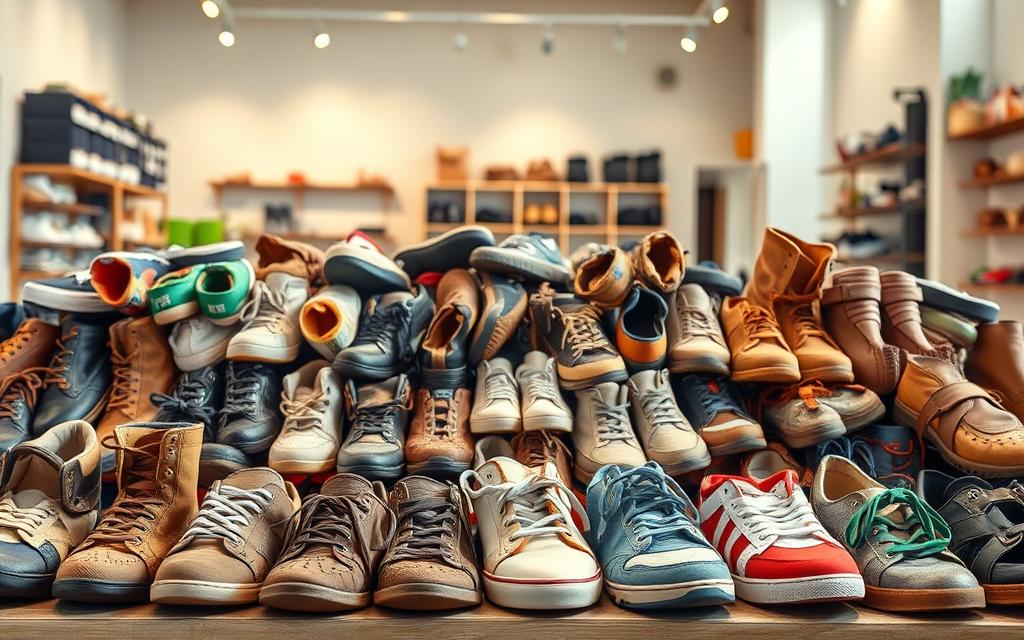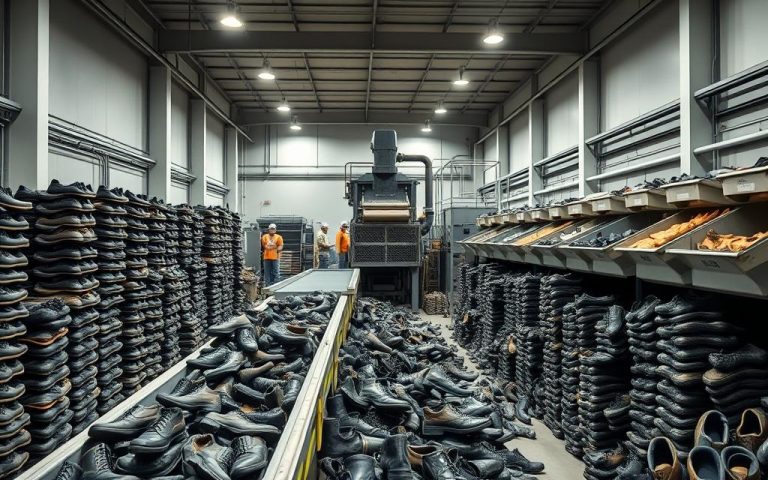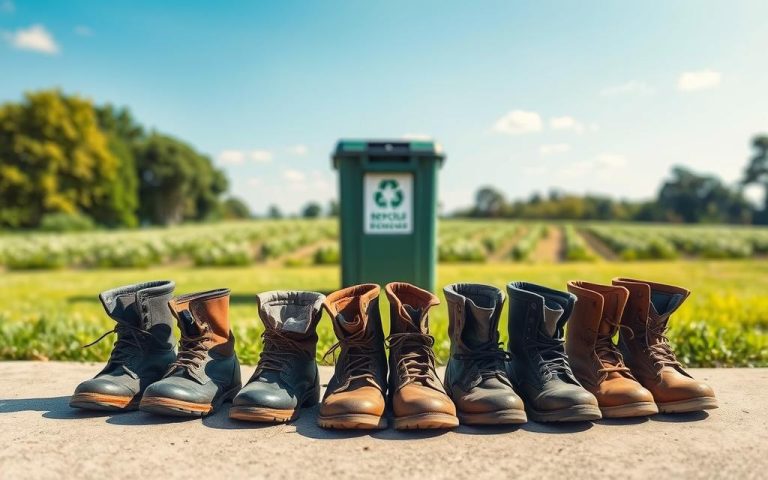Did You Know You Can Recycle at Boots?
The growing concern about environmental impact has led to an increased interest in sustainable practices, including the recycling of footwear.
Footwear waste is a significant problem globally, with millions of pairs ending up in landfills each year.
Boots, a leading retailer, has taken a significant step towards reducing this waste by introducing a recycling program for old shoes. This initiative not only helps in reducing landfill waste but also promotes the reuse of materials.
By participating in this program, customers can contribute to a more sustainable future. This guide will walk you through the process of recycling your old shoes at Boots, highlighting the benefits for both individuals and the environment.
The Environmental Impact of Shoe Waste
The footwear industry has a significant environmental footprint that is often overlooked. With the global demand for shoes continually rising, the issue of shoe waste has become a pressing concern.
Staggering Statistics: Shoes in Landfills
Americans throw away at least 300 million pairs of shoes each year, contributing to the growing problem of shoe waste in landfills. The global footwear industry accounts for 1.4% of global greenhouse gas emissions, with a single pair of sneakers generating about 30 pounds of CO2 emissions.
Decomposition Timeline of Footwear
The decomposition of footwear in landfills is a slow process, with shoes taking anywhere from 30 to 40 years to decompose. This slow decomposition rate is largely due to the synthetic materials and adhesives used in modern footwear.
- Synthetic materials like rubber and plastics can take decades to break down.
- The use of adhesives in footwear construction further complicates the decomposition process.
- As shoes decompose, they release environmental toxins that can contaminate soil and groundwater.
Proper recycling can prevent these lengthy decomposition processes and associated environmental impact. By recycling shoes, we can reduce the amount of waste sent to landfills and minimize the environmental harm caused by the footwear industry.
Understanding Boots’ Recycling Initiative
With its recycling initiative, Boots is making it easier for customers to recycle their old footwear.
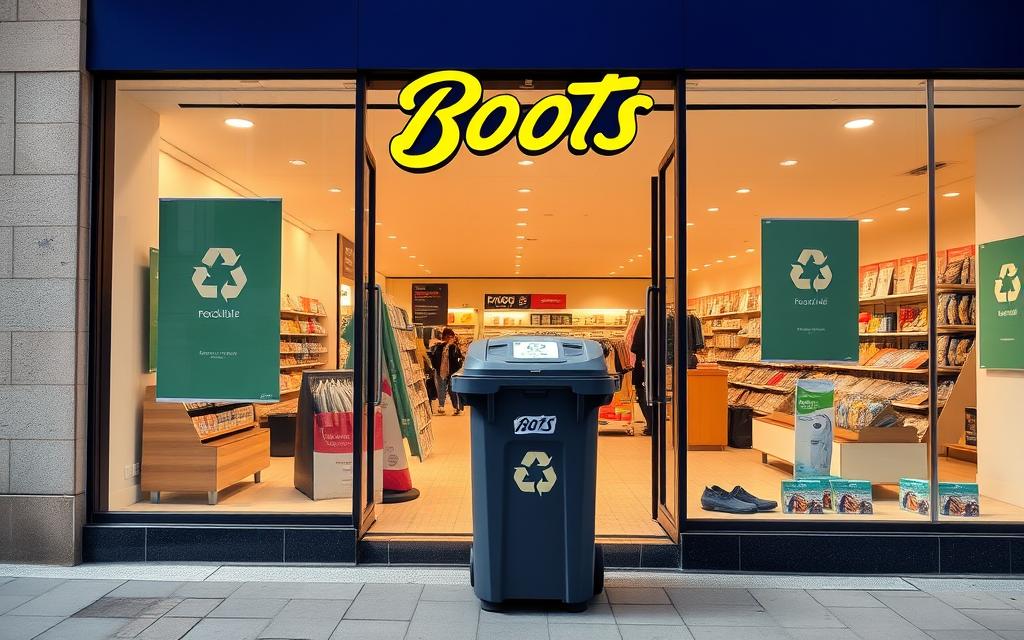
The Boots recycling program is designed to reduce waste and promote sustainability. By encouraging customers to recycle their used footwear, Boots aims to minimize the environmental impact of shoe waste.
How the Boots Recycling Program Works
The program is straightforward: customers bring their used footwear to a Boots store, where it is collected in a specialized Zero Waste Box. This system ensures that the footwear is properly sorted and sent for recycling.
The Zero Waste Box system is designed to be efficient and minimize contamination, ensuring that materials are of high quality for recycling.
The Zero Waste Box System
The Zero Waste Box system is a key component of Boots’ recycling initiative. Developed in partnership with recycling experts, these boxes are designed to collect and store footwear for recycling efficiently.
The boxes are designed to minimize contamination and ensure that materials are of high quality for recycling. Once collected, the footwear is transported to recycling facilities where it is processed into raw materials.
By integrating with broader recycling infrastructure, Boots ensures that the materials from the collected footwear are reused, reducing waste and the demand for new raw materials.
Types of Footwear You Can Recycle at Boots
Boots offers a comprehensive recycling program that accepts a wide range of footwear items. This initiative is part of their commitment to reducing waste and promoting sustainability in the footwear industry.
Accepted Footwear Items
Boots accepts various types of footwear for recycling, including boots, heels, sandals, and shoes. The Zero Waste Box system allows customers to recycle their used footwear easily. This program is designed to be inclusive, ensuring that a broad range of footwear can be recycled.
The types of footwear accepted include:
- Boots of all sizes and styles
- Heels, including high heels and wedge heels
- Sandals, encompassing slide sandals and strapped sandals
- Shoes, including sneakers, dress shoes, and casual footwear
Items Not Accepted for Recycling
While Boots’ recycling program is comprehensive, there are certain items that cannot be recycled through this program. Footwear with significant non-recyclable components, such as heavily glued or contaminated materials, may not be accepted.
A table outlining some of the key differences between accepted and non-accepted items is provided below:
| Footwear Type | Accepted | Not Accepted |
|---|---|---|
| Boots | Leather or synthetic boots | Boots with excessive glue or contamination |
| Shoes | Sneakers and casual shoes | Shoes with significant non-recyclable parts |
| Sandals | Rubber or leather sandals | Sandals with glued or complex components |
Boots determines which items to accept or reject based on the recyclability of the materials and the capabilities of their recycling partners. By understanding what can and cannot be recycled, customers can make informed decisions about their footwear waste.
Step-by-Step Guide to Recycling at Boots
Boots has made it simple to recycle your footwear, and we’re here to guide you through the process. Recycling your old boots is a great way to reduce waste and contribute to a more sustainable future.
Preparing Your Footwear for Recycling
Before you drop off your boots for recycling, there are a few steps you can take to ensure they’re processed efficiently. First, clean the shoes by removing any dirt or debris. This helps recycling programs process the materials more efficiently. If possible, remove any non-recyclable parts, such as metal eyelets or plastic decorations, to make it easier for recycling facilities to handle the shoes.
It’s also helpful to pair the shoes by tying the laces together or using a rubber band to keep the pair together. This keeps the shoes organized and makes the recycling process smoother.
| Preparation Step | Benefit |
|---|---|
| Cleaning the shoes | Efficient processing |
| Removing non-recyclable parts | Easier handling by recycling facilities |
| Pairing the shoes | Keeps shoes organized |
Finding Your Nearest Boots Recycling Point
Locating a Boots store that participates in the recycling program is easy. You can use our online store finder or check our mobile app to find a store near you. Once you’ve located a participating store, look for the designated recycling bins within the store.
- Check store hours to plan your visit
- Combine your recycling drop-off with your regular shopping to maximize convenience
- If you’re in a rural area, consider using our online recycling options or contacting us for alternative solutions
By following these simple steps, you can ensure that your old boots are recycled responsibly. For more information on our recycling program and how we’re working towards a more sustainable future, visit our website.
The Recycling Process: What Happens to Your Old Shoes
The recycling process for shoes is a complex series of steps that ultimately leads to the creation of new products. When you recycle your shoes, they are collected and sent to a recycling facility where they are processed into raw materials.
Material Separation and Processing
The first step in the recycling process is the separation of the shoes into their component parts, such as rubber, leather, and fabric. These materials are then processed into raw materials that can be used to manufacture new products. For instance, rubber soles can be ground into crumb rubber, which is used in athletic surfaces and playgrounds.
Certain shoe brands have developed innovative programs to break down old shoes into their component parts and repurpose them. For example, the Nike Grind program accepts old athletic sneakers from all brands and transforms them into sports surfaces and new shoes.
New Products Created from Recycled Shoes
The raw materials obtained from recycled shoes are used to create a variety of new products. These include athletic surfaces, playground mulch, and even new shoes. Companies like Nike are at the forefront of using recycled shoe materials in their products, demonstrating a commitment to sustainability.
| Material | Recycled Product | Application |
|---|---|---|
| Rubber | Crumb Rubber | Athletic surfaces, playgrounds |
| Leather | Recycled Leather | Fashion accessories, upholstery |
| Fabric | Recycled Fabric | Clothing, textile products |
Benefits of Recycling Your Footwear
Embracing footwear recycling can lead to a significant reduction in landfill waste and promote sustainability. By recycling shoes, we can conserve valuable resources and minimize the environmental footprint associated with producing new footwear.
Environmental Advantages
Recycling footwear offers substantial environmental benefits. It reduces landfill waste by giving materials like rubber, leather, and textiles a second life. This conservation of resources minimizes the need for new raw materials, thereby reducing the environmental impact of extraction and processing.
The process of recycling shoes also contributes to reducing waste in landfills, which is a significant environmental concern. By diverting waste from landfills, we can decrease the production of greenhouse gases associated with decomposition.
Social and Economic Impact
Footwear recycling has a positive social and economic impact. It creates jobs and stimulates economic opportunities in the recycling and manufacturing sectors. Recycling programs can also support community development and local economies by providing resources and infrastructure.
| Economic Benefits | Social Benefits |
|---|---|
| Job creation in recycling sectors | Community development through recycling programs |
| Cost savings for municipalities | Raising awareness about sustainability |
| Stimulating local economies | Promoting eco-friendly behaviors |
By adopting footwear recycling practices, we not only contribute to environmental conservation but also support broader social responsibility and corporate sustainability efforts.
Alternative Recycling Options for Shoes and Boots
While Boots offers a convenient recycling program, other organizations and manufacturers also provide shoe recycling services. This section explores alternative options for recycling your shoes and boots.
Manufacturer Take-Back Programs
Many footwear manufacturers have implemented take-back programs for recycling old shoes. For instance, Nike’s Reuse-A-Shoe program is a well-known initiative that recycles old athletic shoes into new products such as playground surfaces and athletic tracks.

Specialized Recycling Organizations
Organizations like TerraCycle specialize in recycling hard-to-recycle products, including shoes. TerraCycle partners with various brands and retailers to collect and recycle shoes, turning them into raw materials for new products.
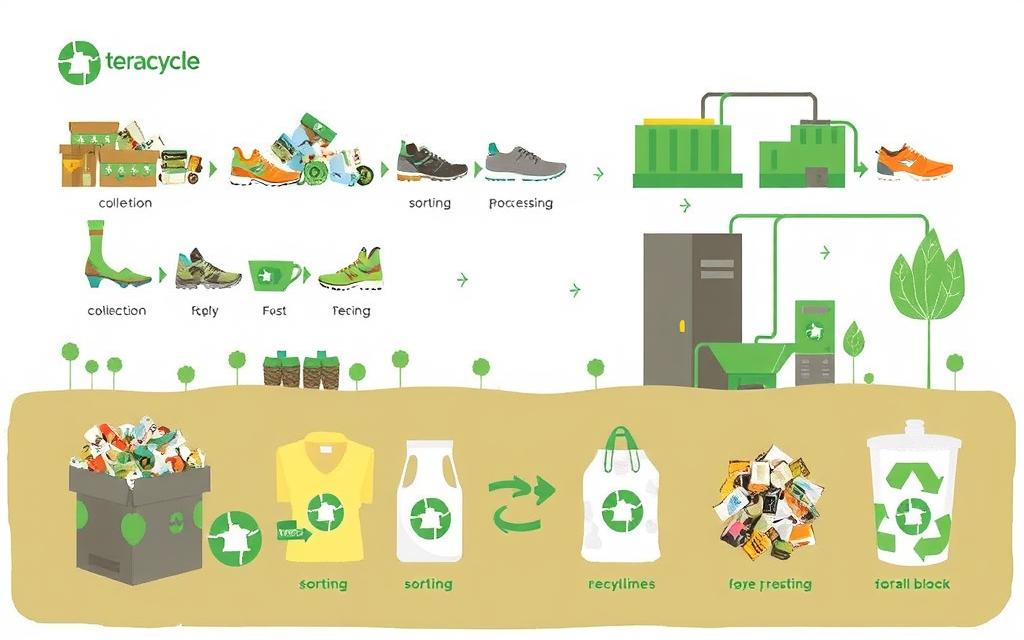
Local Recycling Centers
Local recycling centers can also be a viable option for recycling shoes. Many communities have facilities that accept footwear, either through specific shoe recycling programs or general textile recycling initiatives. To find a local recycling center near you, it’s best to check with your local waste management authority or search online for “local recycling centers that accept shoes.”
- Search online for local recycling centers in your area.
- Contact local waste management authorities for information on shoe recycling.
- Prepare your shoes according to the recycling center’s guidelines.
- Advocate for shoe recycling programs if they’re not available in your area.
By exploring these alternative recycling options, you can contribute to reducing footwear waste and promoting sustainability in your community.
When to Recycle vs. When to Donate Your Footwear
Deciding whether to recycle or donate your footwear can be a straightforward process if you know the right steps to take. The condition and purpose of your shoes play a significant role in making this decision.
Assessing the Condition of Your Shoes
The first step is to evaluate the condition of your shoes. If they are still in good shape, with minimal wear and tear, donating them is a viable option. However, if your shoes are worn out beyond repair, recycling is the more suitable choice.
Inspect your shoes for signs of heavy use, such as sole separation, torn uppers, or significant discoloration. If they’re beyond repair, it’s time to consider recycling.
Donation Programs for Gently Used Footwear
If your shoes are still in decent condition, consider donating them to organizations that accept gently used footwear. Goodwill and Soles4Souls are two prominent charities that welcome shoe donations. Soles4Souls has distributed over 53 million pairs of shoes to those in need, serving a vital purpose in communities worldwide.
Before donating, ensure your shoes are clean and free of damage. Some organizations may have specific guidelines for the types of shoes they accept, so it’s a good idea to check ahead of time.
By choosing to either recycle or donate your footwear, you’re contributing to a more sustainable future and potentially making a significant difference in someone’s life.
Creative Ways to Repurpose Old Shoes Before Recycling
Giving old shoes a new purpose through DIY projects is an eco-friendly alternative to recycling. Before you consider throwing away your worn-out footwear, explore the creative ways to breathe new life into them.
Old shoes can be transformed into unique decorative items or functional products, reducing waste and promoting sustainability.
DIY Projects for Worn-Out Footwear
You can turn old shoes into planters, pen holders, or even wind chimes. For instance, a pair of old boots can be converted into a quirky planter for your garden or indoor space. The key is to think creatively about the potential uses of different shoe types and materials.
Upcycling Ideas for Different Types of Shoes
Different types of shoes lend themselves to various upcycling projects. For example, athletic shoes can be repurposed into dog toys or bags, while dress shoes can be transformed into decorative items like vases or candle holders. The materials used in the shoes, such as leather or fabric, also play a significant role in determining the best upcycling approach.
| Shoe Type | Upcycling Idea | Materials Needed |
|---|---|---|
| Athletic Shoes | Dog Toy | Shoelaces, Stuffing Material |
| Dress Shoes | Decorative Vase | Paint, Glue, Decorative Items |
| Boots | Planter | Soil, Plants, Paint (optional) |
By exploring these creative upcycling ideas, you can give your old shoes a new purpose and reduce waste. For more inspiration, you can visit online communities and resources dedicated to footwear upcycling.
Sustainable Alternatives to Traditional Footwear
With the growing awareness of environmental issues, the demand for sustainable alternatives to traditional footwear is on the rise. Consumers are increasingly looking for shoes that not only reduce waste but are also made from eco-friendly materials.
Eco-Friendly Shoe Materials
The use of eco-friendly materials in shoe production is a significant step towards sustainability. Materials such as recycled polyester, organic cotton, and regenerated leather are becoming more prevalent. For instance, Timberland PRO footwear incorporates a minimum of 50% recycled polyester, setting a high standard for sustainability.
Brands Leading the Way in Sustainable Footwear
Several brands are pioneering sustainable practices in the footwear industry. Timberland is one such brand that has been at the forefront of sustainability for nearly three decades. Other notable brands include those that use regenerative farming techniques and prioritize recycling in their manufacturing processes. When shopping for sustainable footwear, it’s essential to research and evaluate the brands’ sustainability claims and look for recognized certifications.
By choosing sustainable footwear, consumers can significantly reduce their environmental footprint. As more brands adopt eco-friendly practices, the industry is moving towards a more sustainable future.
Reducing Your Footwear Carbon Footprint Beyond Recycling
Beyond recycling, there’s a significant opportunity to reduce our footwear carbon footprint by adopting more sustainable practices. While recycling shoes is a crucial step in managing waste, it’s equally important to consider other strategies that can minimize our environmental impact.
Extending the Life of Your Shoes
One effective way to reduce footwear waste is by extending the life of your shoes. This can be achieved through proper care and maintenance, such as regular cleaning, conditioning, and storing them appropriately. By doing so, you can significantly prolong the lifespan of your footwear, reducing the need for frequent replacements and, consequently, the amount of waste generated.
Furthermore, considering repair options can also contribute to extending the life of your shoes. Many shoe repair services can fix worn-out soles, replace broken zippers, or recondition damaged materials, giving your shoes a new lease on life.
Mindful Purchasing Habits
Adopting mindful purchasing habits is another critical aspect of reducing footwear waste. This involves being more thoughtful and intentional when buying shoes, focusing on quality over quantity, and choosing items that are durable and timeless rather than trendy. Evaluating the cost-per-wear of a pair of shoes can also help in making more sustainable choices, as it encourages consumers to consider the long-term value of their purchases.
Embracing minimalism or adopting a capsule wardrobe approach can further reduce waste. By paring down your shoe collection to only the most essential or beloved items, you not only declutter your space but also contribute to a reduction in the overall demand for new footwear, thereby decreasing the environmental impact associated with producing and disposing of a pair shoes.
Conclusion: Taking Steps Toward Sustainable Footwear Practices
Now that we’ve explored the ins and outs of recycling at Boots, it’s time to take action towards a more sustainable future. By participating in Boots’ recycling program, you can recycle boots and other footwear, significantly reducing the environmental impact of shoe waste.
The recycling guide provided by Boots makes it easy to understand how to prepare your footwear for recycling and where to drop it off. By choosing to recycle shoes rather than sending them to landfills, you’re contributing to a significant reduction in waste and promoting a more circular economy.
As consumers, our individual actions may seem small, but collectively, they create a substantial positive impact. By embracing sustainable practices like recycling shoes and supporting brands that offer recycling programs, we can drive change in the footwear industry. Let’s work together towards a future where footwear recycling is the norm, and the shoes end their life cycle in an environmentally friendly manner.
Share this information with others to expand awareness and participation in footwear recycling. Together, we can make a difference and create a more sustainable future for our planet.
FAQ
What types of footwear can be recycled through the Boots recycling program?
The Boots recycling program accepts various types of footwear, including athletic shoes, sandals, and other types of shoes made from materials like rubber, leather, and synthetic materials.
How do I prepare my footwear for recycling?
To prepare your footwear for recycling, remove any laces, insoles, and other removable parts. Check with the recycling program for specific guidelines on preparing your shoes.
What happens to my old shoes after I recycle them?
After recycling, your old shoes are separated into different materials, such as rubber, leather, and metal, and processed into raw materials that can be used to manufacture new products.
Can I recycle shoes that are damaged or worn out?
Yes, many recycling programs, including Boots, accept shoes that are damaged or worn out. The condition of the shoes may affect the recycling process, but they can still be recycled.
Are there any alternative recycling options for shoes and boots?
Yes, alternative recycling options include manufacturer take-back programs, specialized recycling organizations, and local recycling centers that accept shoes and boots for recycling.
How can I extend the life of my shoes and reduce waste?
To extend the life of your shoes, practice mindful purchasing habits, repair them when needed, and consider repurposing or upcycling old shoes into new products.
What are some eco-friendly shoe materials used by sustainable footwear brands?
Sustainable footwear brands use eco-friendly materials like organic cotton, recycled polyester, and plant-based materials to reduce the environmental impact of their products.
Can I donate my gently used footwear instead of recycling it?
Yes, if your footwear is still in good condition, you can consider donating it to organizations that accept used shoes, extending their life and reducing waste.
